Member
Joined 2003
Reading this thread, seems a lot of people take a large issue with a very narrow hole in the response. I'd like to ask what is the big issue? Why is this so important? I can't figure it out. Seems it's so narrow it wouldn't be audible. Am I wrong?
In the grand scheme, it isn't high on the list. However, for a center channel, the sweet spot is smack in the middle of the listening area...so FR irregularities may be noticed by some listeners.
Plus, I am a little obsessive when I think something can be improved 😉
Could you tell why do we need 2" drivers? They only give extra 1 octave on the mid-bass. Why can't we use compression driver in the range 100-1000Hz?
In the grand scheme, it isn't high on the list. However, for a center channel, the sweet spot is smack in the middle of the listening area...so FR irregularities may be noticed by some listeners.
Plus, I am a little obsessive when I think something can be improved 😉
I do the crossover differently for the center channel for just this reason.
Obsessive about improvements is fine, but ignoring the cost/performance tradeoff is irresponsible.
Could you tell why do we need 2" drivers? They only give extra 1 octave on the mid-bass. Why can't we use compression driver in the range 100-1000Hz?
The main reason for a 2" compression driver is for power handling. I use a 1" down to 600-700 Hz with no problem, but this is for home use not pro. In a home this is fine. But going below 500 Hz with a compression driver is impractical. Not because of the driver, but because of the waveguide. A waveguide for those frequencies gets ridiculous and there is simply no need to do it. And that octave that you get in the midbass you loose at the high end.
Member
Joined 2003
Yes but in a small theater or even at home I can fit 1-2 meters horn (down to 100Hz) without problem. If 2" (4" VC)compression driver cost 80$ so why can't I take 4" for let say 160$?
This is my only significant vice so (IMO) I'm only marginally irresponsible. 🙂
Very nice 🙂
A lot of my listening is done at night at very low levels. In the quietness of the night, listening to the very detail of someone singing or performing is such moving that, yes it can be seducing. Putting even a thin sheet in front is like putting a mask. The difference is that how much of the emotion of the performer you feel when listening to music versus just good music. I don't ever think I will design a speaker with something in front of it.One meter from the diaphragm is very close. This is going to smooth things considerably and this distance cannot be done with a crossover in place without serious problems.
I rotate about the AC as well, but I wouldn't jump at the conclusion about the "better directivity".
And this is because ...? You have some love affair with looking at a diaphragm? (I guess that it depends on where it is!) I've heard this comment before and I don't get it.
If I were measuring a speaker system with multiple drivers, then I would measure further away. Even with single driver, sometimes measuring at different distances can reveal different things. Sometimes it's also necessary to use different measurement methods.
This is my only significant vice so (IMO) I'm only marginally irresponsible. 🙂
Well good lord, start on those other vices! 😀
Besides, what is irresponsible is a matter of opinion.
3 ND1460A: aprox. 350 US each (not including shipping and taxes)
3 large custom waveguides for each ND1460A: "irresponsible"
Grin on owner's face when using the above: *priceless* 😉
For tests, I just ask someone to NC it.Interesting! I'd love to know how you guys build these things. I have ideas, but they all seem complicated and difficult to make a good looking one.
Dan
A lot of my listening is done at night at very low levels. In the quietness of the night, listening to the very detail of someone singing or performing is such moving that, yes it can be seducing. Putting even a thin sheet in front is like putting a mask. The difference is that how much of the emotion of the performer you feel when listening to music versus just good music. I don't ever think I will design a speaker with something in front of it.
If I were measuring a speaker system with multiple drivers, then I would measure further away. Even with single driver, sometimes measuring at different distances can reveal different things. Sometimes it's also necessary to use different measurement methods.
Thank you.
I'm glad someone else hears it...
Yes, a lot of my listening is done at night, at very low levels also, in the dark.
It's not about what's seen, (or measured) it's about what's heard.
No sheets, foam, quilts, or other masks please...
I think that he means that 100% absorptive is also a reflective boundary condition (called pressure release p = 0 as opposed to rigid velocity = 0). To not reflect at all it needs to be the same impedance as free space.
OK. That I understand.
A lot of my listening is done at night at very low levels. In the quietness of the night, listening to the very detail of someone singing or performing is such moving that, yes it can be seducing. Putting even a thin sheet in front is like putting a mask. The difference is that how much of the emotion of the performer you feel when listening to music versus just good music. I don't ever think I will design a speaker with something in front of it.
So you are saying that the materials transfer is not linear - i.e. that it has a different effect at low levels than at high levels? That's simply not true. It's effect is linear (up until very high SPLs) and it is the same at low levels as it is at high levels. It's a constant slight falloff with frequency - perfectly smooth - since the material is non-resonant - and easily compensated for. Quite honestly I think that its all in your head. You don't like the idea, so you hear "bad effects" even when they aren't there.
Thank you.
I'm glad someone else hears it...
Yes, a lot of my listening is done at night, at very low levels also, in the dark.
It's not about what's seen, (or measured) it's about what's heard.
No sheets, foam, quilts, or other masks please...
I've been futzing around with conventional loudspeakers on waveguides for the past week or so. I am not using a foam plug on them. All of my other speakers, from my Unity clones to my Gedlee Summas have the foam plug.
While my direct radiators sound good for about ten minutes, it's a lot easier to listen to waveguides for extended periods of time with the foam plug in place. It *does* take a bit of getting used to. Perhaps we've listened to HOMs for so long that we practically expect them to be a part of the listening experience, and when they're gone you have to reboot your perception to adjust to the new normal.
You have to hear it and listen for awhile. As John said, it takes some getting used to, but once you do, direct radiators are just sound harsh - what you call "detail". They get on my nerves after a short time (maybe thats what Songsc calls "seductive").
You have to hear it and listen for awhile. As John said, it takes some getting used to, but once you do, direct radiators are just sound harsh - what you call "detail". They get on my nerves after a short time (maybe thats what Songsc calls "seductive").
Yes!
I am not a fan of heavy metal, but I was listening to some over my direct radiator waveguides because the guitars sounded so amazing. I was really rockin' out for about three minutes, and then I couldn't take it any longer.
The Summas never do this - they just get louder and louder. It's rarely an "uncomfortable" kind of loud.
I'm seeing a lot of speakers that use waveguides these days. If you audition one, do your best to listen for at least 30-60 minutes, and ask yourself if you feel inclined to turn them down. If you do, you're probably suffering from listener fatigue due to HOMs.
Or at least that's my .02
This could be the basis
Smooth it out by sanding, and plaster
Put fiberglass on it
Sand again
And so forth
Needs to be painted with mold paint
Wetsanded and and vaxed
Then you have a mold
If you want a pro mold I would do a 2-part mold
Its easy, but you need to know how
And you need a counterpart which should be smooth on the outside instead
The mold is made upon that
Size changes and needs to be calculated
Its just work
Yea, doesn't look like fun to DIY. That way may be more difficult that what I was thinking about not doing. Oh well, looks like it's just better to buy in spite of cost unless I can figure out something more clever.
Thanks,
Dan
I gave up on using domes in waveguides a few years ago, but I think I'm ready to take another crack at it. I personally believe that a compression driver is a better solution, but I have a unique problem, and I can't find a way to solve it that doesn't involve a dome tweeter. Here's the situation:
I've built a ton of horns and waveguides, primarily for automotive use. When I first started, I built them full size. We're talking huuuge ol' horns that make the car basically undrivable. This is back in the 90s. As I began building waveguides, I found that you could use boundaries to extend the waveguide. And I don't mean an inch or two. I'm talking about removing over 75% of the waveguide.
Here's the problem I'm running in to: The size of the compression driver itself is really becoming an issue. I can't find compression drivers small enough to fit into corners. The best solution that I've found so far is to bend the throat of the waveguide, so that the compression driver enters at a 45 degree angle. But it's tricky, because the bend creates a dip in the frequency response, and the dip gets deeper as the bend gets bigger. (IE, if the compression driver enters the waveguide at a ninety degree angle you get a big fat dip due to a reflection off the wall of the waveguide.)
Here's the best waveguide I've built. It's an elliptical oblate spheroidal loaded by a BMS 4540ND. It has a horizontal coverage of 108 degrees, vertical of 72, and an average of 90. You can see that the compression driver enters at an angle. This allows me to push it as far back as possible on the dash of my car, which better mates with the angle of the dash and the windshield.
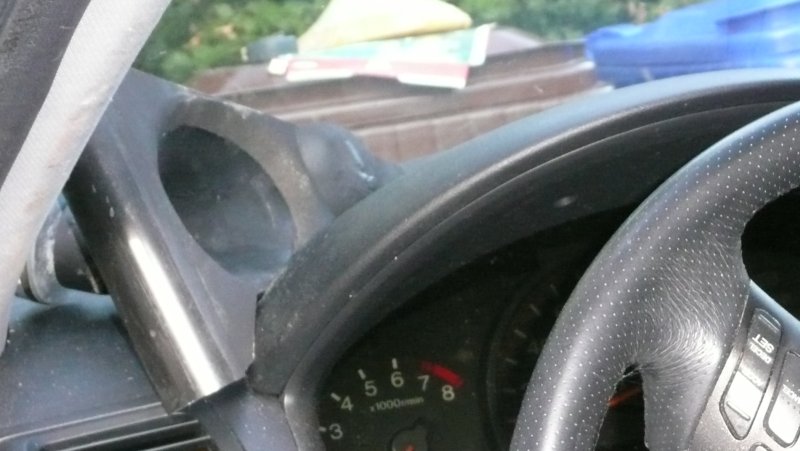
So here's what I'm thinking. If you a neodymium tweeter at the apex of a waveguide instead of a compression driver, you can push that waveguide almost all the way back. By pushing it back further, you can reduce the mouth of the waveguide even further. Basically, you let the windshield and the dash do more of the work.An externally hosted image should be here but it was not working when we last tested it.
Again, not saying that this is a good solution for the home, where depth isn't a problem. But my application is rather unique, and I simply can't think of another way to solve this.
By using a dome tweeter I will lose a great deal of efficiency, reduce power handling, and increase distortion. On the upside, it's smaller, looks better, and costs less. I have a hunch that a phase plug could be built to improve the high frequency polar response. Basically get the dome to behave more like a compression driver, and less like a dome.
As I see it, a compression driver is a big dome tweeter with an extraordinarily powerful motor, and a carefully designed phase plug. Here are two compression drivers that I've used. JBL 2470 on the left, back when I was into huge horns in the car. BMS 4540ND in my hand, once I switched to Unity horns.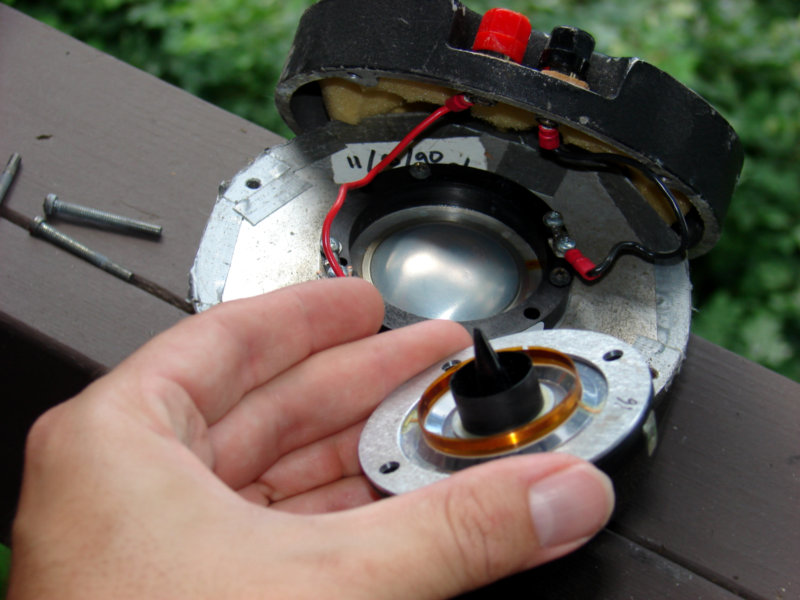
Here's a TAD compression driver cut in half. They had this laying around their demo room when I was there, a rather amazing paperweight if you ask me. In the cross section you can see that this isn't much different than a dome tweeter, except they've added a very carefully designed phase plug in front of the diaphragm, and the dome is inverted.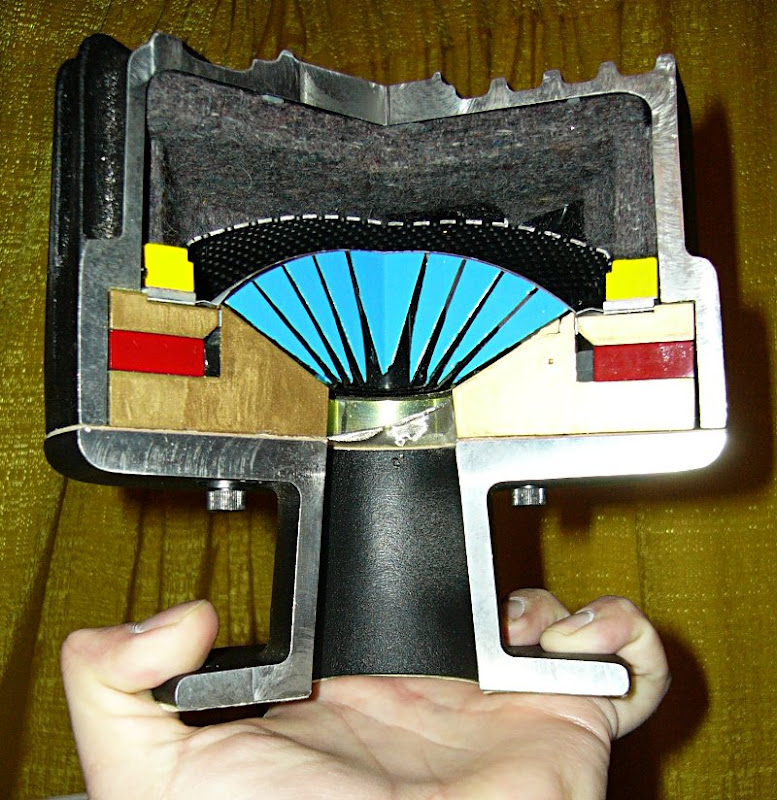
To give you a sense of scale, here's the compression driver that I'm using in my car, mounted on a conventional horn. (woodhorn.com btw.) You can see that the TAD absolutely dwarfs it.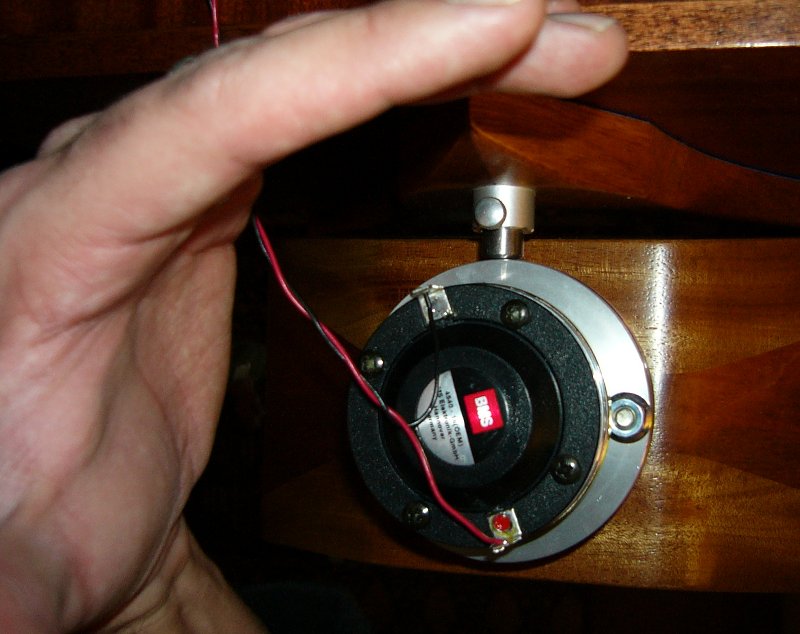
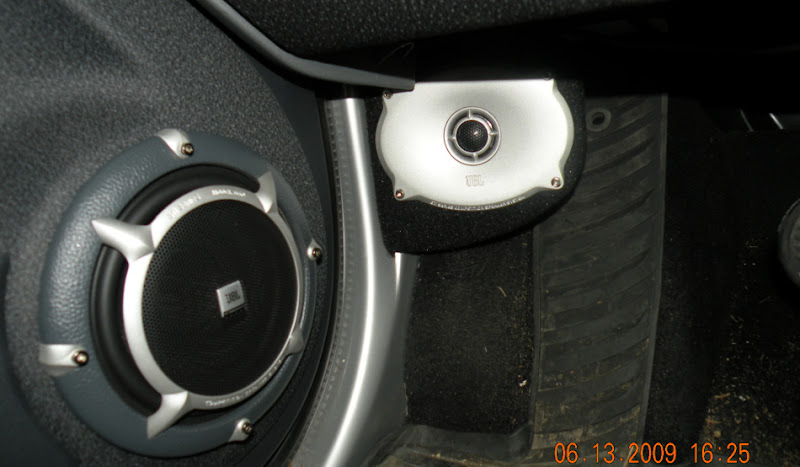
Here's a pic of JBL's top of the line components, which use a waveguide that looks suspiciously like an elliptical oblate spheroidal. My design would be similar to this, but using the windshield to bring the soundstage to eye level, and to extend the curve of the waveguide. (In other words, my waveguides will have a narrower coverage angle than JBL's.)
So I would end up with a waveguide that uses the oblate spheroidal curve, but with a footprint that's about 75% smaller than the waveguides I am already using. I haven't decided yet if it will be a Unity. There *is* enough room to mount a couple of midranges to extend the response. The primary goal will be to reduce the waveguides size to the smallest footprint possible, and use the existing boundaries to extend the curve.
Anyone care to comment on these plans?
I broke this off into a new thread.
http://www.diyaudio.com/forums/multi-way/158741-reducing-waveguide-size.html#post2049175
If I understand high order modes correctly, they are generated when the angle of the duct changes, generating diffraction. Due to this, dome tweeters have the potential to offer lower HOMs than compression drivers. The main problem with conventional domes is lack of a proper phase plug. So you end up with good performance over a limited bandwidth, but the top octave or two is ruined by the lack of a phase plug.
Anyways, the reason I bring this up is that I've stumbled across a compression driver which might offer the best of both worlds.
Give it a look. I'll post measurements once the waveguide's complete.
If I understand high order modes correctly, they are generated when the angle of the duct changes, generating diffraction. Due to this, dome tweeters have the potential to offer lower HOMs than compression drivers.
HOM can be generated by the source - if it doesn't generate the correct shape wavefront for the waveguide, or by the waveguide itself. A dome will generate HOM because it cannot create the flat wavefront required by the waveguide. A compression driver attempts to create a flat wavefront - to what extent it achieves this is highly variable.
Well, to bring things into perselctive, for those whom have driven a car without power steering, when the car is new, when driving down a straight road you have a good feel of control of the car; as the car ages, and hysteresis in the mechanical system increases, you start to feel you need to work harder to keep the car going straight and the steering wheel feels loose, but when you are making turns, the degredation in control is not as much as when driving straight.So you are saying that the materials transfer is not linear - i.e. that it has a different effect at low levels than at high levels? That's simply not true. It's effect is linear (up until very high SPLs) and it is the same at low levels as it is at high levels. It's a constant slight falloff with frequency - perfectly smooth - since the material is non-resonant - and easily compensated for. Quite honestly I think that its all in your head. You don't like the idea, so you hear "bad effects" even when they aren't there.
Most direct radiating drivers either decay slowly, have strong breakup modes; these do sound harsh. I think if we have some CSD plots for the first 0.5ms of various type of systems, I can explain more clearly.You have to hear it and listen for awhile. As John said, it takes some getting used to, but once you do, direct radiators are just sound harsh - what you call "detail". They get on my nerves after a short time (maybe thats what Songsc calls "seductive").
- Home
- Loudspeakers
- Multi-Way
- Geddes on Waveguides